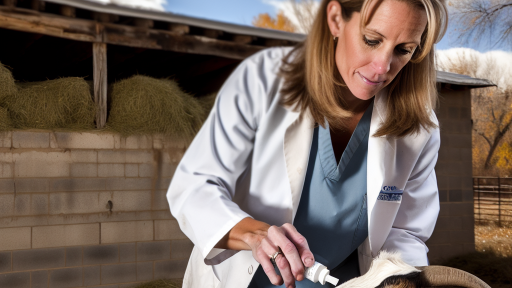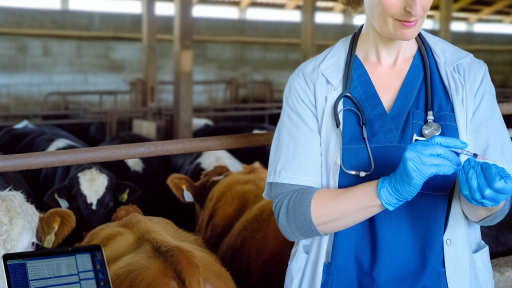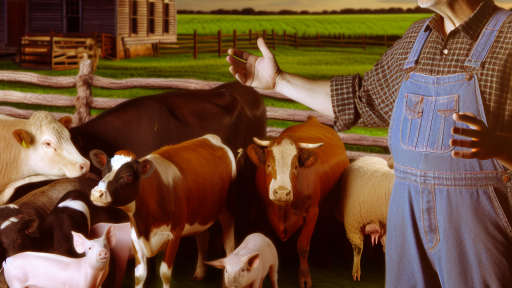Introduction to Inbreeding in Livestock
Inbreeding in livestock refers to the mating of closely related individuals.
This practice has both benefits and drawbacks in animal breeding.
Understanding these aspects is crucial for effective herd management.
Inbreeding can lead to an increased risk of genetic disorders.
This risk arises from a reduction in genetic diversity.
Consequently, genetic variation plays a vital role in livestock health.
Furthermore, inbred populations may experience lower fertility rates.
Additionally, inbreeding can impact overall growth and development.
Therefore, managing inbreeding is essential for sustainable livestock production.
Moreover, farmers need strategies to mitigate inbreeding effects.
The Importance of Genetic Diversity
Genetic diversity contributes to the resilience of livestock populations.
Diverse genetics help populations adapt to environmental changes.
Inbreeding reduces this diversity, making livestock more vulnerable.
Consequently, farmers should prioritize genetic variation in breeding programs.
This approach can enhance herd robustness and productivity.
Transform Your Agribusiness
Unlock your farm's potential with expert advice tailored to your needs. Get actionable steps that drive real results.
Get StartedRecognizing Inbreeding Depression
Inbreeding depression refers to the decline in fitness due to inbreeding.
It manifests through various physical and health-related issues.
Common signs include reduced size, poor health, and infertility.
Additionally, inbred animals may have a compromised immune system.
Thus, recognizing these signs early is crucial for herd management.
Farmers should implement breeding strategies to avoid inbreeding depression.
Strategies for Managing Inbreeding
Farmers can adopt several strategies to manage inbreeding effectively.
- Utilizing pedigree analysis aids in tracking genetic relationships.
- Introducing new breeding stock increases genetic variation.
- Implementing rotational breeding programs prevents inbreeding.
- Conducting genetic testing offers insights into genetic diversity.
Implementing these strategies can enhance herd health and performance.
Ultimately, a balanced approach fosters sustainable livestock production.
Understanding Genetic Diversity
The Importance of Genetic Diversity
Genetic diversity is crucial for livestock populations.
It enhances the adaptability of species.
Moreover, it increases fertility and productivity.
Genetic variation reduces the risk of disease.
This diversity ensures the survival of livestock under changing conditions.
Basic Principles of Population Genetics
Population genetics studies genetic variation within populations.
It focuses on how genes behave across generations.
Understanding allele frequencies is essential in this field.
These frequencies help assess genetic diversity levels.
Additionally, migration introduces new genes to populations.
Factors Influencing Genetic Diversity
Several factors affect genetic diversity in livestock populations.
- Population size is a primary factor.
- Breeding practices can either enhance or reduce diversity.
- Environmental changes impact genetic variation.
- Selection pressures lead to adaptations over time.
Challenges of Inbreeding
Inbreeding reduces genetic diversity significantly.
This process leads to an increase in genetic disorders.
It can also impact overall health and reproduction.
Consequently, management strategies must counteract these effects.
Showcase Your Farming Business
Publish your professional farming services profile on our blog for a one-time fee of $200 and reach a dedicated audience of farmers and agribusiness owners.
Publish Your ProfileGenetic monitoring helps in reducing inbreeding risks.
Strategies to Enhance Genetic Diversity
Implementing proper breeding strategies fosters genetic health.
- Using diverse genetic stock is vital.
- Crossbreeding can introduce new traits.
- Genetic testing identifies valuable breeding candidates.
- Establishing breeding programs supports diversity efforts.
Additionally, preserving local breeds maintains unique genetic characteristics.
Identifying Inbreeding: Signs and Consequences in Livestock
Understanding Inbreeding
Inbreeding occurs when closely related animals mate and produce offspring.
This practice may seem beneficial for maintaining desired traits.
However, it often leads to a lack of genetic diversity.
Consequently, this can increase the risk of inherited disorders.
Signs of Inbreeding in Livestock
Producers should be vigilant for several signs of inbreeding.
One noticeable sign is reduced fertility rates.
Additionally, offspring may exhibit physical deformities.
A decline in overall health and vitality is common.
Inbred animals may also show behavioral issues.
Monitor these signs early to mitigate long-term effects.
Consequences of Inbreeding
The consequences of inbreeding can be severe for livestock populations.
Increased vulnerability to diseases is a significant concern.
Inbred animals may have a greater risk of genetic disorders.
This increases mortality rates among affected animals.
Subsequently, producers face economic losses.
Additionally, inbreeding can impact the productivity of the livestock.
Managing Inbreeding
Effective management strategies can reduce the risks of inbreeding.
Diversifying breeding stock is crucial for healthy populations.
Using genetic testing can identify relatedness among animals.
Implementing rotational breeding systems helps maintain diversity.
Additionally, record-keeping can track lineage effectively.
Finally, working with geneticists can optimize breeding practices.
Learn More: Proper Loading Techniques for Livestock Vehicles
Tools for Assessing Inbreeding
Genetic Testing
Genetic testing plays a crucial role in managing inbreeding in livestock populations.
This method analyzes the DNA of animals to identify genetic variation.
By determining genetic diversity, breeders can assess inbreeding risks.
Furthermore, genetic tests provide insights into desirable traits.
For instance, DNA sequencing can help trace lineage effectively.
Additionally, parentage testing ensures accurate breeding decisions.
This level of precision helps in monitoring genetic health over generations.
Genetic Indexing
Genetic indexing is another essential tool in managing inbreeding.
This technique evaluates genetic traits based on performance records.
The approach allows breeders to make informed choices about mate selection.
Moreover, it calculates the breeding value of livestock accurately.
Indexing can facilitate the identification of inbreeding coefficients.
These coefficients illustrate the degree of inbreeding in a particular lineage.
Consequently, breeders can strategically plan mating to enhance diversity.
Showcase Your Farming Business
Publish your professional farming services profile on our blog for a one-time fee of $200 and reach a dedicated audience of farmers and agribusiness owners.
Publish Your ProfileTools for Monitoring Inbreeding Levels
Implementing effective monitoring tools enhances inbreeding management.
Various software applications assist in tracking genetic data.
Programs like Pedigree Analyzer streamline the analysis of lineage.
Additionally, these tools can generate reports on genetic health trends.
Regular monitoring supports proactive measures against inbreeding.
Ultimately, utilizing technology empowers breeders to maintain healthy populations.
Explore Further: Genetic Selection Techniques for Livestock Management
Strategies for Managing Inbreeding
Breeding Programs
Effective breeding programs are essential in managing inbreeding.
These programs should prioritize genetic diversity.
This can be achieved through careful selection of breeding pairs.
Selecting animals that are less related helps maintain genetic variation.
Moreover, utilizing genetic testing can inform breeding decisions.
For example, DNA markers can identify potential genetic weaknesses.
Additionally, incorporating crossbreeding with different breeds can be beneficial.
This practice enhances traits and expands the gene pool.
Genetic Management Techniques
Genetic management involves monitoring the genetic health of livestock populations.
Maintaining accurate records is crucial for effective management.
These records should include ancestry and performance metrics.
Regular evaluations of the breeding stock help avoid inbreeding.
Implementing rotational breeding strategies can also be effective.
Rotation minimizes mating between closely related individuals.
Use of artificial insemination provides access to diverse genetics.
This technique allows for the introduction of unrelated genes.
Monitoring Inbreeding Levels
Monitoring inbreeding levels is vital for sustainable livestock production.
Tools like pedigree analysis and inbreeding coefficients are useful.
These tools help assess the genetic diversity within populations.
Proactively addressing inbreeding issues can prevent long-term problems.
Early identification of inbreeding depression allows for timely interventions.
Industry Collaboration
Collaboration among breeders is essential for managing inbreeding.
Sharing information and best practices can improve genetic strategies.
Establishing breed associations can facilitate these collaborations.
These associations often provide resources on genetic tools.
Furthermore, collective efforts enhance the overall genetic diversity.
Delve into the Subject: Selecting the Right Sheep for Your Farm

Outcrossing: Benefits and Risks in Livestock Breeding
Understanding Outcrossing
Outcrossing involves breeding animals from different genetic backgrounds.
This practice reduces the risks associated with inbreeding.
It helps introduce new traits and enhance genetic diversity.
Benefits of Outcrossing
One significant benefit is increased vigor in livestock populations.
Outcrossing often leads to higher fertility rates.
Animals resulting from outcrossing tend to have improved growth rates.
Showcase Your Farming Business
Publish your professional farming services profile on our blog for a one-time fee of $200 and reach a dedicated audience of farmers and agribusiness owners.
Publish Your ProfileAdditionally, they show better resistance to diseases.
These advantages contribute to overall herd health and productivity.
Enhancing Genetic Diversity
Outcrossing enhances genetic diversity within populations.
Genetic diversity is crucial for adapting to changing environments.
More variation increases resilience against diseases and climate changes.
By introducing new breeds, farmers can strengthen their stock.
Risks of Outcrossing
Despite its advantages, outcrossing carries certain risks.
One risk is the introduction of undesirable traits into the herd.
Crossbreeding can sometimes result in a loss of desirable characteristics.
Careful planning is essential to minimize these risks.
Managing Outcrossing Effectively
Farmers should assess genetic backgrounds before outcrossing.
It is advisable to consult geneticists for tailored breeding programs.
Additionally, maintaining thorough records assists in effective management.
Regular health evaluations ensure the benefits of outcrossing are realized.
Therefore, careful implementation can lead to successful breeding outcomes.
Discover More: Best Practices for Breeding Fish in Aquaculture Systems
Utilizing Technology: DNA Sequencing and Genomic Selection
Introduction to DNA Sequencing
DNA sequencing plays a crucial role in managing inbreeding in livestock populations.
This technology allows for accurate identification of genetic makeups.
As a result, it helps breeders make informed decisions.
Benefits of DNA Sequencing
One significant advantage of DNA sequencing is increased genetic diversity.
With this technique, breeders can detect and eliminate harmful genes.
Moreover, it helps in tracking ancestry and lineage effectively.
Genomic Selection Explained
Genomic selection builds on the foundation of DNA sequencing.
This approach uses genomic data to predict the breeding value of animals.
Consequently, breeders can select the best candidates for mating.
Advantages of Genomic Selection
Genomic selection offers several benefits for livestock breeding.
- It accelerates genetic gain for desired traits.
- Furthermore, it reduces the time needed for data collection.
- This method enhances the accuracy of breeding decisions.
Practical Applications in Livestock Management
Farmers can implement DNA sequencing and genomic selection effectively.
While working together, these technologies improve overall herd health.
Additionally, they promote sustainable breeding practices.
Challenges and Considerations
Despite its advantages, challenges remain in adopting these technologies.
Cost is a significant factor that can deter smaller farmers.
Furthermore, there can be a steep learning curve with newer technologies.
The Future of Genetic Management in Livestock
The future looks promising with continued advancements in these technologies.
As techniques become more accessible, wider adoption is likely.
Ultimately, this will lead to healthier livestock populations worldwide.
Case Studies: Successful Management of Inbreeding in Various Livestock Species
Cattle Breeding Programs
Many cattle breeders face inbreeding challenges.
To address this, the Greenfield Ranch implemented a comprehensive breeding program.
The program focused on using artificial insemination techniques.
This practice introduced genetic diversity into the population.
As a result, the health and productivity of the cattle improved significantly.
Showcase Your Farming Business
Publish your professional farming services profile on our blog for a one-time fee of $200 and reach a dedicated audience of farmers and agribusiness owners.
Publish Your ProfileSheep Genetic Management
The Pleasant Valley Farm encountered inbreeding issues with its sheep flock.
To resolve this, they collaborated with geneticists.
This collaboration allowed them to track genetic markers accurately.
They established a rotational breeding system incorporating outside rams.
This system successfully reduced the inbreeding coefficient.
Consequently, lamb survival rates increased, reflecting better genetic health.
Pig Breeding Innovations
Pig breeding operations often struggle with inbreeding depression.
The Happy Hooves Farm adopted advanced genetic testing methods.
They used genomics to identify the best breeding stock.
This approach significantly minimized inbreeding and increased litter sizes.
Farmers noticed healthier piglets with improved growth rates.
Poultry Production Improvement
The Sunny Side Poultry Company faced declining egg production.
In response, they reviewed their breeding practices thoroughly.
They incorporated a diverse selection of egg-laying breeds.
This strategy helped maintain a robust genetic pool.
As a result, overall production and flock vitality saw marked enhancement.
Equine Bloodline Management
Riding schools often deal with inbreeding in their horse populations.
The Galloping Meadows Riding School recognized this issue early.
They introduced an outcrossing plan with thoroughbred horses.
This plan improved both performance and health across the board.
The horses exhibited better stamina and agility in competitions.
Strategies for Effective Inbreeding Management
- Utilize artificial insemination to introduce new genetic material.
- Employ rotational breeding systems with external stock.
- Incorporate advanced genetic testing and genomics.
- Maintain diversity through strategic outcrossing.
- Continuously monitor inbreeding coefficients and health outcomes.
Success in managing inbreeding leads to healthier livestock populations.
Additional Resources
309 Beyond predictions: managing inbreeding and variability in the …




